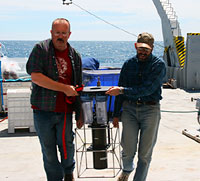

 | |||||||||||||||
|
|
Journals 2008/2009Jeff Lawrence
December 27, 2008 There is a hole in the deck of the REVELLE that allows the ocean below to enter into it. This hole is in the CTD hangar and allows the REVELLE to be fitted with a large round column to use in other scientific expeditions that need specialized equipment put over the side. The water we were in on this day was a gorgeous turquoise blue. No outside light is getting to this hole under the ship. We shut the doors on the CTD hangar so no outside light could reach in. The color comes from the reflective light from outside the ship. Notice in the photo that light is upwelling from the hole. Many time,s water this color means that coccolithophores are present. Barney (Dr. Balch) is using up to date satellite photos from NASA showing where the blooms are most prevalent. You can tell that coccolithophores are Dr. Balch's passion. He is very enthusiastic about finding them and collecting water samples. Barney works tirelessly to find the best places to collect samples of coccolithophore. Water of this color is a good indicator that the coccolithophores may be present and reflecting the blue spectrum of light that is in the ocean.
Each scientist aboard the REVELLE has a special interest and reason that they are on this cruise. The main emphasis of course is the coccolithophore, although many other marine microorganisms have been found. On board a ship, it is important that all hands be available for a station. If you are available when something is going in the water or someone needs a hand, you help. Everyone helps one another because there are many jobs too big for one or two people. So, a schedule is posted everyday of what is going overboard and the approximate time. That gives everyone notice that help may be needed at a specific place and time on the ship. Every stop by the ship probably includes a CTD deployment, which could happen as many as 8-10 times a day. Also around solar noon the OCP will be going off the fantail and every few days the SAPS pump will also go off the fantail and the ship will hold its position until it is recovered. Only one thing at a time will go overboard, this is for safety reasons. I help with most deployments on the ship from noon to midnight. I also collect water samples on every other CTD deployment along with nutrients. Then I take the water to the main lab and filter five separate protocols so that the filters can be taken back to Bigelow Labs for further analysis.
Questions of the Day:
|
||||||||||||||


